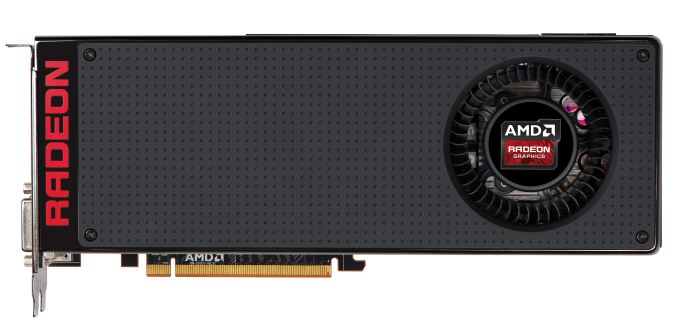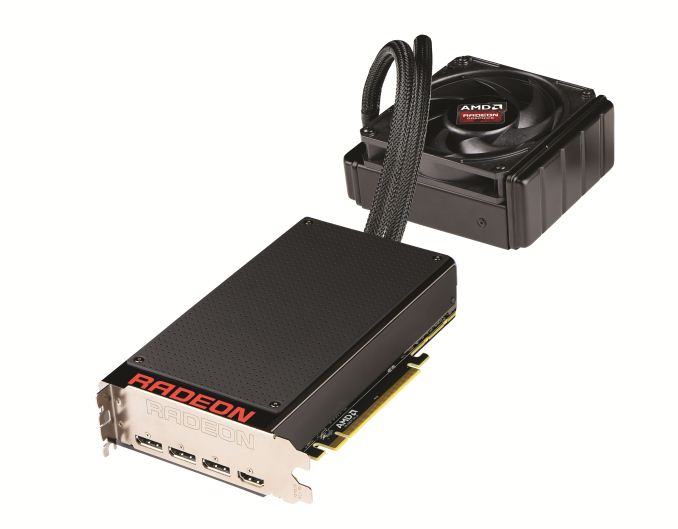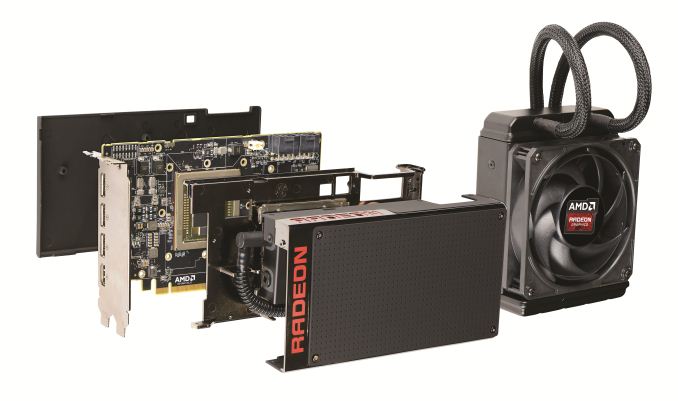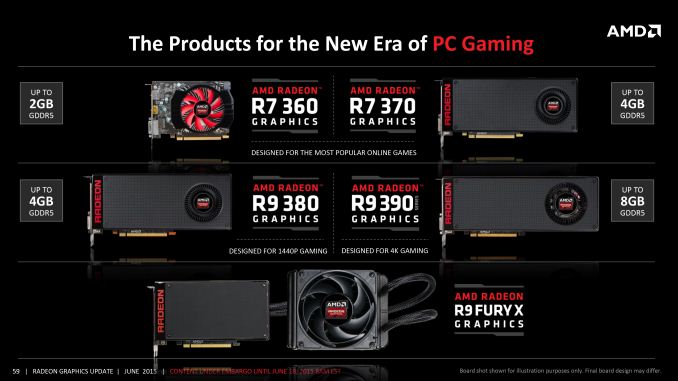AMD Launches Retail Radeon 300 Series: A Prelude To Fury
by Ryan Smith on June 18, 2015 10:35 AM EST- Posted in
- GPUs
- AMD
- Radeon
- Radeon 300

Throughout the last couple of months AMD has been in the process of carefully and deliberately rolling out their latest generation of video cards. In a multi-staged process we have seen AMD engage in a what is best described as a drawn-out teaser and an early technical briefing, announcing their intention to roll out a new high-end video card this quarter, further teasing the public with pictures of the card, and then in the middle of all of that giving the technical press an in-depth briefing on AMD’s key next-generation memory technology, High Bandwidth Memory. While AMD did their best to make sure the details of the cards were kept under wraps – with varying results – AMD definitely wanted to make sure the world would know that their card was coming.
Catching up to the present, earlier this week AMD held their 2015 GPU product showcase, dubbed “The New Era of PC Gaming.” As the latest stage in AMD’s master plan, AMD held a public event in Los Angeles similar to their 2014 GPU product showcase in Hawaii, where the company announced their product lineup ahead of the full launch of the products in question. In the presentation we learned some (but not all) of the details surrounding AMD’s Radeon 300 series, including the numbered products from 360 to 390, and of course the company’s new high-end flagship video card, the Radeon R9 Fury X.
All told the showcase itself was something of a teaser itself – we got prices, but not complete specifications – but we also received confirmation of AMD’s rollout plans. The next stage, coinciding with today’s article, is the formal launch of the numbered members of the Radeon 300 series, which are product refreshes based on existing AMD GPUs, similar to what we saw with the 200 series in 2013. Meanwhile today is also the greater unveiling (but not the launch) of the Fury series, with AMD allowing us to share more details about the new card and its specifications. Following today’s announcements and launches, the Radeon R9 Fury X will be launching in just under a week from now, on June 24th, and then after that the R9 Fury (vanilla) will be launching on July 14th.
| AMD R9 300 Series Specification Comparison | ||||||
| AMD Radeon R9 Fury X | AMD Radeon R9 Fury | AMD Radeon R9 390X | AMD Radeon R9 390 | |||
| Stream Processors | 4096 | (Fewer) | 2816 | 2560 | ||
| Texture Units | 256 | (How much) | 176 | 160 | ||
| ROPs | 64 | (Depnds) | 64 | 64 | ||
| Boost Clock | 1050MHz | (On Yields) | 1050MHz | 1000MHz | ||
| Memory Clock | 1Gbps HBM | (Memory Too) | 5Gbps GDDR5 | 5Gbps GDDR5 | ||
| Memory Bus Width | 4096-bit | 4096-bit | 512-bit | 512-bit | ||
| VRAM | 4GB | 4GB | 8GB | 8GB | ||
| FP64 | 1/16 | 1/16 | 1/8 | 1/8 | ||
| TrueAudio | Y | Y | Y | Y | ||
| Transistor Count | N/A | N/A | 6.2B | 6.2B | ||
| Typical Board Power | 275W | (High) | 275W | 275W | ||
| Manufacturing Process | TSMC 28nm | TSMC 28nm | TSMC 28nm | TSMC 28nm | ||
| Architecture | GCN 1.2 | GCN 1.2 | GCN 1.1 | GCN 1.1 | ||
| GPU | Fiji | Fiji | Hawaii | Hawaii | ||
| Launch Date | 06/24/15 | 07/14/15 | 06/18/15 | 06/18/15 | ||
| Launch Price | $649 | $549 | $429 | $329 | ||
Overall AMD is launching an almost top-to-bottom refresh of its product lineup overnight. Between now and July 14th the company and its partners will introduce cards from $109 to $649, and while there are a few gaps that AMD is almost certainly purposely leaving in place to give them something to announce later this year, overall we’re seeing more or less AMD’s entire hand for 2015 and early 2016 in one go.
As for the subjects at hand today, there are really two stories to talk about. The first is of course the Radeon R9 Fury series, the products that will house AMD’s newest flagship GPU, Fiji. While I won’t butter up Fiji from an architectural standpoint at this time, what Fiji does bring to the table are two very big changes for AMD. The first of these is of course high bandwidth memory, which not only gives AMD more VRAM bandwidth than ever before, but it outright changes how GPUs video cards are constructed. The second big change is that Fiji is just very big. At 596mm2 AMD went right to the reticle limit, putting AMD squarely into the big GPU race.
But before Fury comes the rest of the 300 series. We'll take a look at Fury in due time - while we've been briefed on the subject and have been authorized to discuss it, we want to hold back for when we have the hardware in hand - so our focus for today will be on what's launching today, and that's the Radeon 300 series.
Being released today are five new cards from AMD’s partners, which will form the backbone of the Radeon 300 series from $109 to $429. To our regular readers these parts will be familiar – and to some, perhaps more familiar than they’d like – while for AMD the 300 series represents their 3rd generation of retail 28nm products.













290 Comments
View All Comments
AS118 - Thursday, June 18, 2015 - link
Interesting stuff. I hope that the 300 series has more tweaks than just better binning and higher clocks at lower voltages. Based on what they've said about the 390's, I'm guessing they've made at least some slight architectural tweaks.That said, I feel that the Fiji / Fury line is the real stuff to watch with this launch, and to a lesser extent, the 4gb version of Tonga in the 380. If they release a 380x with 384-bit vram, that might be quite interesting too.
The fact that the 380 / Tonga has full support for Freesync and good DX12 support makes it the one I'm most interested in. I hope AMD can turn it around with this launch and get Nvidia down from its 75% marketshare dominance, which is not great for competition at all.
I like NVidia (especially EVGA cards), but I'm going to try my best to buy and promote AMD until the marketshare's more even.
just4U - Thursday, June 18, 2015 - link
I was looking at the 4G variant of 380 released by Asus/MSI today.. I'd be impressed if the price wasn't $80 CAD higher than the 2G variants.. which pushes me away from it and looking at the 390 instead.Leyawiin - Thursday, June 18, 2015 - link
HardOCP's review of the R9 390 and R9 390X show them to be a straight up rebrand of the 290 and 290X with 8GB of VRAM a single card can't use. No one should be surprised though - its been known that the R9 and R7 series will be nothing but two to three year old cards with slightly different clocks and more memory. But yeah, the niche high end Fiji cards - woo hoo and all. Two new cards with new architecture after two to three years of circling the airport. Bravo AMD.just4U - Thursday, June 18, 2015 - link
What review were you reading? I read HardOCP review as well.. and all they did was call AMD out on it's 4K push.. as they stated that it will take two cards to fully utilize the additional memory (no surprise there.. as neither the 980 nor the 290x are great cards for that but the 390x may be once you factor in crossfire)revanchrist - Thursday, June 18, 2015 - link
Learn more before you post. There are 4 Fury cards getting launched.just4U - Thursday, June 18, 2015 - link
From their bottom Line:"As it is, we will leave it there for you all to discuss the merits of Radeon R9 390X. At $429 the MSI R9 390X GAMING 8G is priced better than GeForce GTX 980, and finally gives the GTX 980 competition from AMD, which was lacking until now."
gorg_graggel - Thursday, June 18, 2015 - link
So, apparently AMD has allowed the press to publish AMD's internal benchmarks.Sorry, the article is in german, but scroll down for the slides (these are in english). One is benchmarks, one is benchmark settings. They are directly from AMD:
http://www.pcgameshardware.de/AMD-Radeon-Grafikkar...
Looking good so far i'd say. :)
While they are likely cherry picked and all, the provided settings should help put things more into perspective.
gorg_graggel - Thursday, June 18, 2015 - link
Oh yeah, I meant Benchmarks for Fury ofc. :)gorg_graggel - Thursday, June 18, 2015 - link
Another addendum: (this comments section lacks an edit button. :P)It's in 4K (and includes Shadow of Mordor).
chizow - Thursday, June 18, 2015 - link
What's more interesting is why AMD turns off AF in more than half of those games? Is something wrong with Fiji's TMUs? Doesn't make any sense, 16xAF has been trivial for years since 9700pro (typically 10% perf hit or less) and a staple for any benchmark since at least a few gens before then.